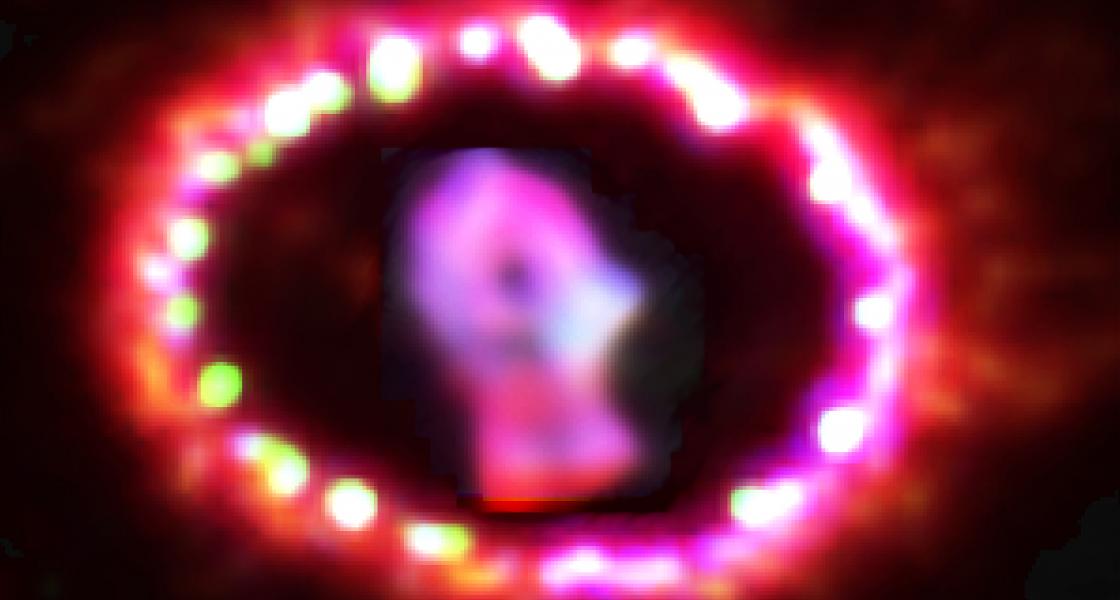Supernova 1987A is illuminating its own past. The brightest supernova to light up Earth’s night skies since the Renaissance, it appeared in the southern sky on February 23, 1987 when a blue supergiant star exploded in the Large Magellanic Cloud, a galaxy located 160,000 light years from Earth. For nearly 25 years, Fellow Dick McCray and his colleagues have studied the unfolding story of this remarkable event in the visible, ultraviolet, and x-ray wavelengths. Today, the scientists not only understand the star’s spectacular demise, but also are now learning about the blue supergiant’s chemistry prior to going supernova.
For instance, there are four pieces of circumstantial evidence that the blue supergiant was undergoing a core merger of two stars when it blew up. First, the cylindrical symmetry of the explosion (illuminated in the center of a recent Hubble Space Telescope picture, shown here) suggests the presence of two stellar cores. Second, there are two outer rings out beyond the one that is brightly illuminated in the picture. These rings strongly resemble the planetary nebulae surrounding binary star systems. Third, because a second star isn’t anywhere to be found, it must have merged with the blue supergiant. Finally, blue supergiant stars typically don’t go supernova. Ordinarily, huge red supergiant stars, which are as big as our solar system, are the stars that explode. However, the merger of two stellar cores would be capable of causing a relatively small blue supergiant star to explode.
The two-star merger theory also explains a key step in the evolution of the star that exploded. About 20,000 years before the supernova, a red supergiant star (formed when the two stars initially began to merge) shed a dense outer layer and became a smaller blue supergiant star. About ten years after the supernova, a ring composed of the ejected outer layer of the star began to light up. Hot spots developed when the supernova shockwave began to enter dense fingers of gas that protrude inward from the edge of the dense ring. These fingers had been formed prior to the supernova by the interaction of the ring with a high-speed stellar wind emanating from the blue supergiant star. This wind also sculpted out the cavity between the star and the ring, which is now completely encircled by hot spots.
Evidence supporting these theories about the evolution and explosion of the blue supergiant star has been available for some time. However, recent ultraviolet and x-ray images are adding new information about the blue supergiant star that exploded.
For instance, the newly refurbished Space Telescope Imaging Spectrograph (STIS) aboard the Hubble Space Telescope began sending ultraviolet (UV) spectra of the debris cloud and the circumstellar ring in 2010 after a hiatus of more than six years. In comparing two spectral emission lines produced by the main stellar ingredient hydrogen, the researchers discovered that one of them, called Lyman-alpha, is produced primarily in the ring’s hot spots and scattered toward the observer by collisions with hydrogen atoms in the debris. The other, called H-alpha, comes from hydrogen atoms in the debris entering shocked gas near the rings.
A more sensitive instrument, the Cosmic Origins Spectrograph (COS) installed in 2009 on the Hubble Space Telescope was able to detect UV lines emitted by trace elements in the debris as the debris impacted the circumstellar ring. With COS, the scientists identified clear signals from carbon, nitrogen, and helium ions emitted by the debris.
When the scientists compared the ratio of nitrogen to hydrogen in the ring and in the supernova explosion debris, they found ten times more nitrogen and ten times less carbon in the debris cloud than in the ring. They had already determined that the ring itself had ten times more nitrogen than the interstellar space around it. The explanation for this finding lies in the chemistry of the supernova progenitors.
The nuclear furnace inside the original red supergiant star had already been converting carbon and oxygen to nitrogen when it shed the outer layer. This process accounts for the tenfold enrichment of nitrogen in the circumstellar ring. However, during the 20,000 years before the supernova, the nuclear furnace in the smaller blue supergiant continued to forge new nitrogen from carbon and oxygen. By the time the star exploded, its nitrogen content had increased tenfold and its carbon content had dropped tenfold.
Evidence of stellar chemistry has also been detected by NASA’s Chandra X-Ray Observatory. After 25 years, the stellar explosion appears to have overtaken the ring, creating a reverse shock wave that is illuminating the supernova debris with x-rays. (Shock heating is also making the debris glow in visible light.) The x-rays are expected to reveal even more information about the star(s) whose merger led to Supernova 1987A.




